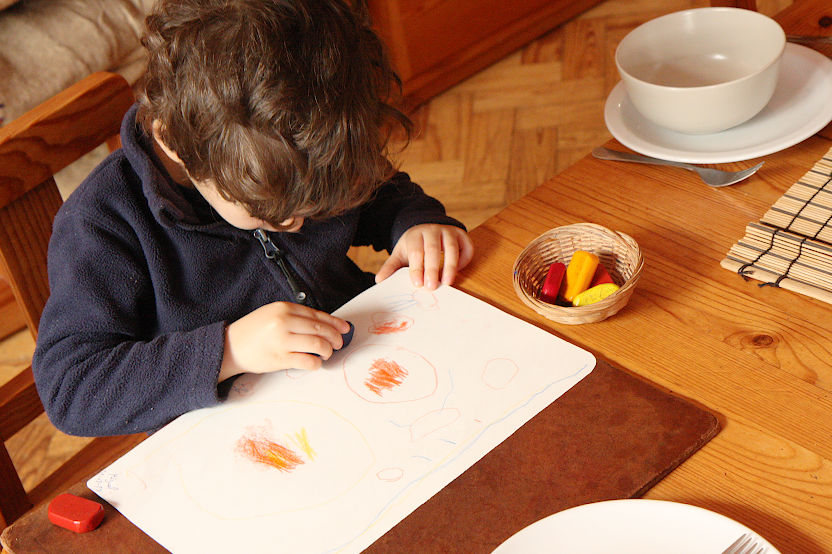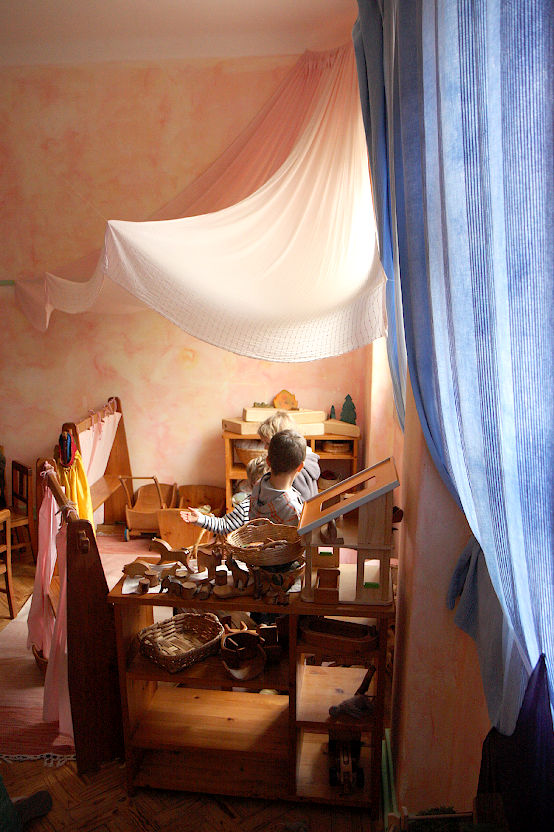Our highest task should be to form free human beings who are capable of, by themselves, finding meaning and direction for their lives.
Rudolf Steiner
To know this Kindergarten is to enter in a very special place where happiness and life spread in a natural and open way. A blanket of warmth and strong generosity welcomes everyone who arrives here, coming from so many places.
The Kindergarten – Waldorf International Infância Viva – functions based on the pedagogy of Rudolf Steiner – Waldorf Pedagogy, being a branch of Anthroposophy. Anthroposophy is based on a humanist vision that promotes the harmonious development of humans as physical, etheric and spiritual beings. The Waldorf curriculum in the Kindergarten is alive, dynamic and integrated. It stresses the holistic development of children, their individual differences and an emphasis in the discovery of their capacities and potential. It respects each stage of development of each child.

The main goal of Waldorf Pedagogy is to develop human beings capable, by themselves, to give sense and direction to their lives, to develop in the child “head, heart and limbs” (intellectual, emotional and active) through a curriculum that balances domestic activities with artistic activities. This curriculum inserts music and arts along with other subjects such as gardening, handicraft and modelling. Through this method, the educators strive to awaken a love for learning in the children so they can learn and do and learn and be in all of its totality.
The classroom of the Kindergarten is characterized by a peaceful environment which gives space and time for each child to express themselves, and, as such, they are able to revel their true nature.
In terms of education, the greatest need of the first seven years of life rests in the human and physical realm surrounding the child. This realm should transmit, through the experiences that it offers the child, that the world that surrounds the child is good. It’s this goodness lived while still in a state of unconsciousness that forms the foundation of acting consciously that, in a confident and courageous way, will persist throughout the children’s lives, defending them and protecting them. The characteristics of the surrounding physical world should contain the truth and purity of materials that nature offers us, and the immense diversity of sensations that the body of a child captures and saves like a inheritance to later come and understand the richness of life. In Educative Offer – Waldorf Curriculum.
Our educative project gives an essential value to free play, as well as the daily practice of artistic and domestic activities, in a practical and beautiful sense. These activities are namely, modelling, sewing, dough making for bread, drawing with beeswax crayons, painting with watercolours, wood working, and taking care of the garden. These activities contrast with the moments of calmness, verses, songs, fairy tales and theatre. In this way, awakening the artistic sensibility through regular work makes it possible to strengthen the will and interests of the child in a way that the child comes to understand the world and its contents and comes to live different contexts, experiences and situations in a systematic and integrated way. The imagination, fantasy and sociability are all highly valued. It is in play that the child interacts with the world starting from their inside, exploring from their genuine interest, discovering space and the other, and in the end building their house that they will live in for the rest of their lives.
If the child is able to entirely give themselves to the world and their surrounding through their play, then in their adult life they will be able to confidently and strongly dedicate themselves in service to the world.
Rudolf Steiner.
The first seven years of the life of a child are characterized essentially by the development of their body, a process of progressive individualization in which the child’s characteristics come to find an adequate way to harbour the future development of their individuality. The child’s necessities emerge from this physicality under construction, and this is processed beyond their own consciousness which is still sleeping. The child lives immersed in everything around them, without distinguishing themselves. For this very reason, they find themselves totally open to their surroundings’ influence. This openness envelopes the enormous capacity that the child has to imitate the world around them as a way to learn. Around three years of age, when, little by little their self-consciousness starts to awaken, the child gains consciousness of themselves and comes to the discovery of that which is “I.” At the same time they learn that things exist around them as foreign and strange objects which are separate from themselves. So begins the process of individualization, separating the “subject-being” from the “world of objects”, permeated more and more intensely by likes and dislikes.

In terms of education, the greatest need of these first seven years rests in the human and physical realm surrounding the child. These surroundings should transmit, through the experiences of the child, that the world that surrounds them is good. It’s this goodness lived while still in a state of unconsciousness that forms the foundation of acting consciously that, in a confident and courageous way, will persist throughout the children’s lives, defending them and protecting them.
The characteristics of the surrounding physical world should contain the truth and purity of materials that nature offers us, and the immense diversity of sensations that the body of a child captures and saves like a inheritance to later come and understand the richness of life.
The human world, the model where the child consumes the quality of Humanity itself, should be able to prepare itself daily to receive the child, feeding the hope and confidence which naturally comes ingrained in the child. The quality that the adult puts on their permanent process of self-learning, of which the results a child will capture and imitate not by what the adult does but by what the adult is, will leave its mark in the evolutionary process of each child.
In Educative Offer – Waldorf Curriculum
Understanding and supporting a child in their process of full development gathers what each of us brings to support the child’s potential. This potential is just a seed in this first stage of infancy.
From the principles themselves of Waldorf Pedagogy, we understand that all of the spaces in which the child puts themselves are educational spaces, and so each space is equally cared for and organized by this principle. From the kitchen, to the multi-purpose room, to the hall, all of the spaces fit into the care given to aesthetics and education. Each space can be used as a continuation of the classroom, as long as it is pedagogical chosen to be this way. The Kindergarten is seen as a house that is a welcome space which brings a feeling of safety to the child. It is a space where everyone cares for each other and is cared for by each other to create healthy and rich growth. In this way the careful pedagogical decisions involve all of the spaces and the various elements of the team, just like a family.